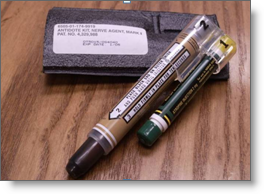You are here: Home > Strategic National Stockpile > CHEMPACK

Atropine autoinjector and
pralidoxime chloride autoinjector (2-PAM)
CHEMPACK
- Overview
- CHEMPACK Benefits
- CHEMPACK Provisions
- CHEMPACK Containers
- Fielding and Maintenance
- The Way Ahead
- Enterprise CHEMPACK
- Integrated Program Team (IPT)
(HHS/CDC, Division of Strategic National Stockpile)
Overview
The CHEMPACK program began as an initiative of CDC's Division of Strategic National Stockpile (SNS) in 1983 before oversight and operational control of the SNS and CHEMPACK moved to the Assistant Secretary for Preparedness and Response (ASPR) in early 2018. It provides antidotes (three countermeasures used concomitantly) to nerve agents for pre-positioning by State, local, and/or tribal officials throughout the U.S. CHEMPACK Program is envisioned as a comprehensive capability for the effective use of medical countermeasures in the event of an attack on civilians with nerve agents. The Enterprise CHEMPACK program would build upon the existing system, improving it by adding an education, training, and exercise component and by optimizing the pre-positioning of antidotes.
- CHEMPACK MISSION
- Provide, monitor and maintain a nationwide program for the forward placement of nerve agent antidotes.
- To provide state and local governments a sustainable resource; and improve their capability to respond quickly to a nerve agent incident.
- WHY CHEMPACK?
- Strategic National Stockpile (SNS) has a 12-hour response time, too long in the event of a chemical attack
- State and local governments have limited or no chemical/nerve agent antidote stocks
- Hospitals carry very limited supplies of treatments for nerve agent exposures
- Nerve agent antidotes are costly and have variable shelf lives (not an easily sustainable resource)
- BACKGROUND
- The CHEMPACK Program pilot was established in September 2002.
- Three Project Areas participated (South Dakota, Washington State and New York City)
- Tested the concept of forward placement of SNS-owned chemical / nerve agent antidotes
- Determined feasibility of the tested strategy
- Lessons learned used to refine processes for the nationwide program
- The CHEMPACK Program pilot was established in September 2002.
CHEMPACK Benefits
- Pre-position containers for faster response times during an emergency
- Extended shelf life of SNS-owned assets to save in overall costs
- Local control of critical life-saving assets to ensure assets are dispensed timely
- Federal management of product life cycle to ensure quality of products
CHEMPACK Provisions
- The Program supplies material, approved storage containers and monitoring equipment
- Project Areas are required to provide secure, environmentally controlled storage areas with phone connectivity
- The Program monitors temperature and container entry 24/7
- Project Areas are required to sign a Memorandum of Agreement to store and use material according to program guidelines
CHEMPACK Containers

CHEMPACK containers are self-contained units placed in centralized locations to enable first responders to quickly administer life-saving antidotes and save lives. There are two types of containers:
- EMS containers
- Geared to first responders
- 85% auto injectors
- 454 casualty capacity
- Hospital containers
- Geared to clinical care environment
- 85% Multi-dose vials
- 1,000 casualty capacity
Fielding and Maintenance
- Cache Site Survey and Fielding
- Logisticians evaluate proposed storage site for compliance with Program requirements
- Maintenance Technician establishes connectivity and alarm functionality with CDC
- Maintenance Visits
- DSNS Maintenance Technicians conduct maintenance visits as required to repair or replace malfunctioning monitoring units
- Container Movements
- CHEMPACK Teams support movement of existing containers within host sites and between facilities in the Project Area as required
- Sustainment
- Inventory teams monitor shelf life of container contents and rotate product during site visits prior to product expiration
The Way Ahead
- Continuous sustainment of all CHEMPACK sites
- Fielding of the 8 remaining Project Areas (5 U.S. territories and 3 associated Pacific Island Nations)
- Formulary component review and restructuring
Enterprise CHEMPACK
The CHEMPACK program began as an initiative of CDC's Division of Strategic National Stockpile (SNS) in 1983 before oversight and operational control of the SNS and CHEMPACK moved to the Assistant Secretary for Preparedness and Response (ASPR) in early 2018. It provides antidotes (three countermeasures used concomitantly) to nerve agents for pre-positioning by State, local, and/or tribal officials throughout the U.S. The proposed Enterprise CHEMPACK program would build upon the existing system, improving it by adding an education, training, and exercise component and by optimizing the pre-positioning of antidotes. The Enterprise CHEMPACK Program is envisioned as a comprehensive capability for the effective use of medical countermeasures in the event of an attack on civilians with nerve agents. Clinical competency, logistics and operations, including training of responders and pre-positioning of countermeasures, as well as the formulary, are addressed.
Proposed Enterprise CHEMPACK program includes:
- Education, training and exercises
- Far forward pre-positioning of antidotes
- Improvements to formulary as next generation medical countermeasures become available
Integrated Program Team (IPT)
- Description:
- Develop overall strategies for developing, acquiring, deploying and using the high priority medical countermeasures identified in the HHS Public Health Emergency Medical Countermeasures Enterprise (PHEMCE) Implementation Plan or by request of the Enterprise Executive Committee.
- Membership:
- Interagency Subject Matter Experts; chaired by The Biomedical Advanced Research and Development Authority (BARDA)
- Deliverables:
- Monitor Medical Countermeasures (MCM) developmental pipeline (tech watch)
- Threat-specific BARDA Medical Countermeasure Plan
- Annual progress reports
- Receive reports from Project Coordinating Teams (PCT) and alert Enterprise Executive Committee to any significant delay or change in the projected schedule
